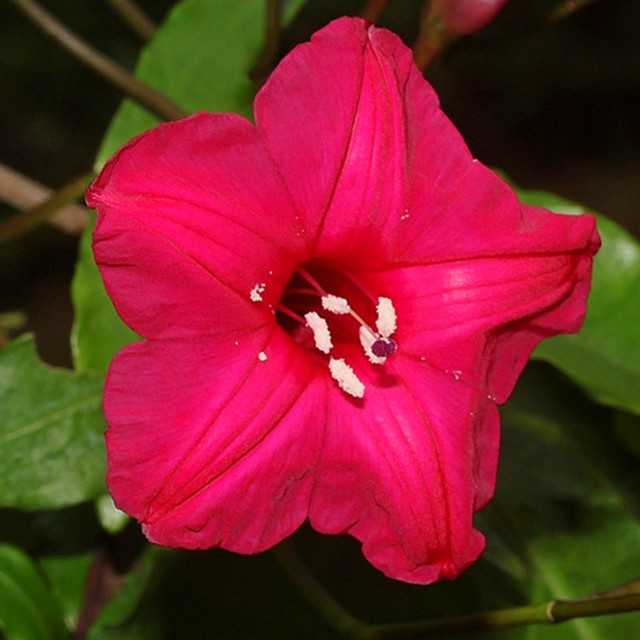The bright magenta flowers of the Prince Kuhio vine recommend it as a dramatic addition to any garden. Well-suited to cover a fence, drape over a trellis or crawl over a rocky outcropping, this member of the Convolvulaceae or morning glory family is easily cultivated in Kona.
In the Ipomea genus, the Prince’s vine is closely related to many morning glory species that grow here and to our sweet potato (Ipomea batatas). The vine’s botanical name Ipomea horsfalliae honors Charles Horsefall, who first cultivated the plant in his native England from seeds or slips collected in South America. The plant is native to several Caribbean islands and Brazil.
Hawaii’s Prince Kuhio fell in love with this vine during his European travels in the late 1800s and brought it back with him upon his return home. A close relative of King Kalakaua, the prince inherited Queen Kapiolani’s Waikiki estate called Pualeilani when she died in 1899. When he returned from his travels shortly after her death, he installed this beloved plant in his new garden. Based on his affection for the plant and its presence in his garden, the flowering vine bears his name here in Hawaii. Today, the plant grows as an ornamental in many tropical or sub-tropical locales where it is known by other names. It is sometimes known as Lady Doorly’s morning glory or in Queensland, Australia, as cardinal creeper.
In 1918, Kuhio opened Pualeilani’s oceanfront portion to the public. Upon his death in 1922, it became Kuhio Beach Park. The hotel Waikiki Prince Kuhio and the Kuhio Beach Park occupy the grounds today. Hopefully, a specimen of the Prince Kuhio vine remains somewhere on the property.
The Prince Kuhio vine is a fast-growing, twining perennial that can climb up to 30 feet on a wall, fence or pergola. The dark green leaves are deeply lobed into three or five parts and fill in the vine. Producing lots of bright magenta flowers nearly year-round, the vine provides a colorful accent wherever it grows. The trumpet-shaped blossoms are 1 to 2 inches across and have a distinct five-point star etched into the colorful petals. The plant does not usually fruit or produce seeds so propagation is reliant on cuttings.
To grow new plants you’ll need to find one growing. Scour your neighborhood and check out public areas where it might be established. Once you find a healthy plant, remove several older stems, about 4 to 6 inches long. Remove most of the leaves from the stem and cut those that remain in half. Dip the bottom of the cutting in rooting hormone and place them in a large pot filled with a 50:50 mix of perlite and vermiculite. Keep the medium moist (not wet) and the cuttings should develop roots within a month to six weeks. Once new leaves begin to appear and there is some resistance when you to gently pull on the cutting you can assume roots are developing. At this point you can transplant to a pot of soil and fertilize lightly to encourage more growth. Plant it out in the garden or in a container when it appears to be a healthy specimen. It should begin flowering in less than a year.
The vine grows well in full sun or partial shade in almost any soil type that drains well. It is fairly drought tolerant, once established, and requires little maintenance. Occasional pruning may be necessary to control growth and the vine will recover quickly even when pruned severely. Fertilizing should be limited to a light application twice a year. Over fertilizing results in lots of succulent leaves that attract insect pests and can also cause reduced flowering. Pests that do appear can usually be controlled with soap and oil treatments.
If you cannot find a specimen to propagate from, check local nurseries to see if they carry it or can order it for you. Though it may be difficult to find, it will be worth the effort once its striking colorful accent is part of your garden.
Email plant questions to konamg@ctahr.hawaii.edu for answers by Certified Master Gardeners. Some questions will be chosen for inclusion in this column.
Diana Duff is a plant adviser, educator and consultant living on an organic farm in Captain Cook.
Gardening Events
Saturday: “Work Day at Amy Greenwell Garden” from 9 a.m. to 12:30 p.m. Meet at the Visitor Center across from the Manago Hotel in Captain Cook. Volunteers will be able to help with garden maintenance and should bring a brown bag lunch. Water and snacks provided. For more information, call Peter at 323-3318.
Farmer Direct Markets
Wednesday: “Sunset Farmers Market,” 2 p.m. to sunset at the north makai corner of the Kmart parking lot.
Wednesday and Friday: “Ho’oulu Farmers Market,” 9 a.m. to 2 p.m. at Sheraton Kona Resort and Spa at Keauhou Bay
Friday: “Pure Kona Market,” 9 a.m. to 5 p.m. at Amy Greenwell Garden in Captain Cook
Saturday: “Keauhou Farmers Market,” 8 a.m. to noon at Keauhou Shopping Center
“Kamuela Farmer’s Market,” 7 a.m. to noon at Pukalani Stables
Sunday: “Pure Kona Green Market,” 9 a.m. to 2 p.m. at Amy Greenwell Garden in Captain Cook
Tuesday through Saturday: “U-Pick greens and produce,” 10 a.m. to 4 p.m. at Tropical Edibles Nursery in Captain Cook.
Plant Advice Lines
Anytime: konamg@ctahr.hawaii.edu
Tuesdays and Thursdays: 9 a.m. to noon at UH-CES in Kainaliu, 322-4892
Mondays, Tuesdays and Fridays: 9 a.m. to noon at UH-CES at Komohana in Hilo, 981-5199 or himga@hawaii.edu






